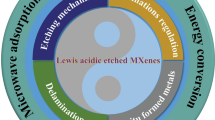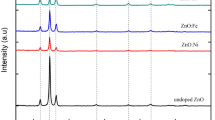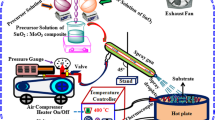Abstract
Due to significant band gap, high refractive index, dielectric permittivity, photoluminescence, dielectric permittivity prominent photoconductivity and photocatalytic activity, preparation of bismuth oxide (Bi2O3) coating has been a topic of extensive research and has potential applications involving microelectronics, sensor technology, opticalcoating, etc. In this study, the coating of nano-Bi2O3 was successfully fabricated via environment-friendly aqueous electrophoretic deposition (EPD). The EPD behavior of nano-Bi2O3 in aqueous dispersion was affected by the addition of nitric acid. Some factors influencing deposition behavior such as addition amount of nitric and particle concentration were investigated. For a typical EPD with nano-Bi2O3 of 1 g L−1, the deposition rate increase with addition amount of nitric acid at first due to the improvement in surface charging of nano-Bi2O3 particles caused by absorption of hydrogen ion, and then would decline when higher concentration of nitric acid (>2 mM) was added due to serious water electrolysis. For the purpose of obtaining higher deposition rate of nano-Bi2O3 in aqueous suspension which was limited by lower deposition voltage, it was suggested to employ higher suspension concentration of Bi2O3. Correspondingly, higher addition amount of nitric acid is desired for sufficient surface charging for more nano-Bi2O3 particles. The environment-friendly aqueous deposition system provides a green EPD for successfully fabricating Bi2O3 coating with many potential applications.







Similar content being viewed by others
References
L. Leontie, M. Caraman, M. Alexe, C. Harnagea, Structural and optical characteristics of bismuth oxide thin films. Surf. Sci. 507–510, 6 (2002)
L.L. Yang, Q.F. Han, J. Zhao, J.W. Zhu, X. Wang, W.H. Ma, Synthesis of Bi2O3 architectures in DMF–H2O solution by precipitation method and their photocatalytic activity. J. Alloy. Compd. 614, 353–359 (2014)
C.L. Yu, W.Q. Zhou, L.H. Zhu, G. Li, K. Yang, R.C. Jin, Integrating plasmonic Au nanorods with dendritic like α-Bi2O3/Bi2O2CO3 heterostructures for superior visible-light-driven photocatalysis. Appl. Catal. B 184, 1–11 (2016)
K. Barrera-Mota, M. Bizarro, M. Castellino, A. Tagliaferro, A. Hernandez, S.E. Rodil, Spray deposited beta-Bi2O3 nanostructured films with visible photocatalytic activity for solar water treatment. Photochem. Photobiol. Sci. 14, 1110–1119 (2015)
Z.J. Li, L.D. Wang, H.Y. Yue, W.D. Fei, Effect of Bi2O3 coating on interfacial wettability and tensile properties of Al18B4O33w/Al composite. J. Mater. Sci. 42, 9355–9358 (2007)
C.L. Gomez, O. Depablos-Rivera, J.C. Medina, P. Silva-Bermudez, S. Muhl, A. Zeinert et al., Stabilization of the delta-phase in Bi2O3 thin films. Solid State Ionics 255, 147–152 (2014)
R. Chen, W. Hu, L. Zou, B. Li, D. Bao, Highly uniform resistive switching effect in amorphous Bi2O3 thin films fabricated by a low-temperature photochemical solution deposition method. Appl. Phys. A 120, 379–384 (2015)
J. Morasch, S.Y. Li, J. Brötz, W. Jaegermann, A. Klein, Reactively magnetron sputtered Bi2O3 thin films: analysis of structure, optoelectronic, interface, and photovoltaic properties. Phys. Status Solidi (a) 211, 93–100 (2014)
K. Brezesinski, R. Ostermann, P. Hartmann, J. Perlich, T. Brezesinski, Exceptional photocatalytic activity of ordered mesoporous β-Bi2O3 thin films and electrospun nanofiber mats. Chem. Mater. 22, 3079–3085 (2010)
S.W. Kang, S.W. Rhee, Growth of bismuth oxide films by direct liquid injection-metal organic chemical vapor deposition with Bi(tmhd)3 (tmhd: 2,2,6,6-tetramethyl-3,5-heptanedione). Thin Solid Films 468, 79–83 (2004)
V. Fruth, M. Popa, D. Berger, R. Ramer, M. Gartner, A. Ciulei et al., Deposition and characterisation of bismuth oxide thin films. J. Eur. Ceram. Soc. 25, 2171–2174 (2005)
H.T. Fan, S.S. Pan, X.M. Teng, C. Ye, G.H. Li, L.D. Zhang, δ-Bi2O3 thin films prepared by reactive sputtering: fabrication and characterization. Thin Solid Films 513, 142–147 (2006)
L. Leontie, M. Caraman, I. Evtodiev, E. Cuculescu, A. Mija, Optical properties of bismuth oxide thin films prepared by reactive d.c. magnetron sputtering onto p-GaSe (Cu). Phys. Status Solidi (a) 205, 2052–2056 (2008)
P. Lunca Popa, S. Sønderby, S. Kerdsongpanya, J. Lu, N. Bonanos, P. Eklund, Highly oriented δ-Bi2O3 thin films stable at room temperature synthesized by reactive magnetron sputtering. J. Appl. Phys. 113, 046101 (2013)
L. Cao, X.Q. Lu, F. Pu, X.L. Yin, Y. Xia, W. Huang et al., Facile fabrication of superhydrophobic Bi/Bi2O3 surfaces with hierarchical micro-nanostructures by electroless deposition or electrodeposition. Appl. Surf. Sci. 288, 558–563 (2014)
B.L. Zhu, X.Z. Zhao, Study on structure and optical properties of Bi2O3 thin films prepared by reactive pulsed laser deposition. Opt. Mater. 29, 192–198 (2006)
H.T. Zhang, X. Zhang, D.C. Zhang, X.Z. Sun, H. Lin, C.H. Wang et al., One-step electrophoretic deposition of reduced graphene oxide and Ni(OH)2 composite films for controlled syntheses supercapacitor electrodes. J. Phys. Chem. B 117, 1616–1627 (2013)
E. Ghasemi, A.M. Arabi, Electrophoretic deposition of kaolin: effects of Al/(Al plus Si) ratio, surface charge, mineral, structural and morphological properties. J. Mater. Sci.: Mater. Electron. 26, 6997–7005 (2015)
L.M. Guo, X.H. Wang, C.F. Zhong, L.T. Li, Magnetic properties of TiO2/Ni hybrid nanotube arrays by electrophoretic deposition. J. Alloy. Compd. 534, 6–8 (2012)
I. Mazurenko, M. Etienne, O. Tananaiko, V. Urbanova, V. Zaitsev, A. Walcarius, Electrophoretic deposition of macroporous carbon nanotube assemblies for electrochemical applications. Carbon 53, 302–312 (2013)
C. Ponzoni, R. Rosa, M. Cannio, V. Buscaglia, E. Finocchio, P. Nanni et al., Electrophoretic deposition of multiferroic BiFeO3 sub-micrometric particles from stabilized suspensions. J. Eur. Ceram. Soc. 33, 1325–1333 (2013)
S. Novak, K. König, Fabrication of alumina parts by electrophoretic deposition from ethanol and aqueous suspensions. Ceram. Int. 35, 2823–2829 (2009)
W. Li, Facile synthesis of monodisperse Bi2O3 nanoparticles. Mater. Chem. Phys. 99, 174–180 (2006)
Author information
Authors and Affiliations
Corresponding author
Ethics declarations
Conflict of interest
The authors declare no competing financial interests.
Rights and permissions
About this article
Cite this article
Zhang, D., Xiang, Q. Green electrophoretic deposition of Bi2O3 coating. J Mater Sci: Mater Electron 27, 11995–11999 (2016). https://doi.org/10.1007/s10854-016-5346-z
Received:
Accepted:
Published:
Issue Date:
DOI: https://doi.org/10.1007/s10854-016-5346-z




